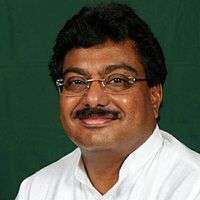M. B. Patil
| M. B. Patil | |
|---|---|
 | |
| Minister for Water Resources, Government of Karnataka | |
|
Assumed office 17 May 2013 | |
| Preceded by | Basavaraj Bommai |
| MLA | |
|
Assumed office 17 May 2013 | |
| Constituency | Babaleshwar |
| Personal details | |
| Born |
7 October 1964 Bijapur, Karnataka, India |
| Nationality | Indian |
| Political party | |
| Spouse(s) | Asha Patil |
| Relations |
B. M. Patil (father) |
| Alma mater | Dr. P.G. Halakatti College of Engineering and Technology |
| Profession | Politician |
| Religion | Hindu-Lingayath |
Mallanagouda Basanagouda Patil (Kannada: ಮಲ್ಲನಗೌಡ ಬಸವನಗೌಡ ಪಾಟೀಲ್), popularly known as M. B. Patil (born 7 October 1964) is an Indian politician from Bijapur who has been Minister for Water Resources in the Government of Karnataka since 2013.[1] He is former member of the Lok Sabha[2] and is the fourth time being elected as a member of Karnataka Legislative Assembly. He is also currently the president of BLDE Association which provides education to the rural masses. He has led various water and development projects. He is the elder son of B. M. Patil, a politician and an educationist. He is committed to irrigate over 6.5 lakh hectares in Karnataka and make Bijapur-Bagalkot the agricultural hub. His vision has also led to the beginning of water tourism and pragmatic development in the Water Resources Department.
Education
M. B. Patil finished his Bachelors in Engineering, Civil at the BLDEA's Vachana Pitamaha P G Halakatti College of Engineering. His leadership qualities were evident since school life. He held various youth leadership positions in his student life. He also possessed skills in architecture and public works. Although his father was a politician his personal leadership and social qualities are said to immensely commendable.
As an educationist
He led the BLDEA group to greater standards and established the establishment of the BLDE University. The 100-year-old Association had a strong foundation, he led the same BLDEA to rebuild its infrastructure to greater heights for the present day. Thus strengthening the image of the century old association, which was instrumentally guided previously by Vacana Pitamaha P.G. Halakatti, Shivayogi Sanganabasava Swamiji of Banthanal and B. M. Patil. M. B. Patil also did focus into quality education in rural areas. His vision to build a quality education infrastructure in the backward district of Bijapur did come true with the establishment of the BLDE University. He believes like his late father that education can cure many ills of society. Providing education he believes is a responsibility of every stake holder in society.
Politics
M. B. Patil known for his love for the society in entirety has lived up to the image of his father B. M. Patil. He is known to be a truly secular politician loved by all sections of society equally. He is called as politician with a difference who not only looks at the short term needs for development, but also has a great long term vision for development. He is widely appreciated for making the legendary dream of water irrigation in Bijapur and Bagalkot district come true. He has immense interests in bringing tourism to Bijapur, which is widely known as a great destination for architecture. His skills in architecture and public works played a vital role in envisioning the "Kere neeru thumbuva Yogana" along with other members of BLDEA's Engineering College. This achievement of M B Patil is said to be a milestone in the history of Bijapur district's development in water irrigation amongst other developmental works in Babaleshwar.
Personal life
M. B. Patil is married to Asha Patil and has two sons, Basanagouda Patil and Dhruv Patil. He is a regular practitioner of yoga. He is known for his interest in reading history and philosophy. He is a passionate reader on Buddhism, Basava Philosophy and those ideologies that are well known propagators of peace and equality.
References
- ↑ "As ministers step in, Soudha springs back to life". The Times of India. 2013-05-21. Retrieved 2013-05-21.
- ↑ "'Krishna's yatra received good response'". The Hindu. 6 April 2004. Retrieved 31 May 2011.